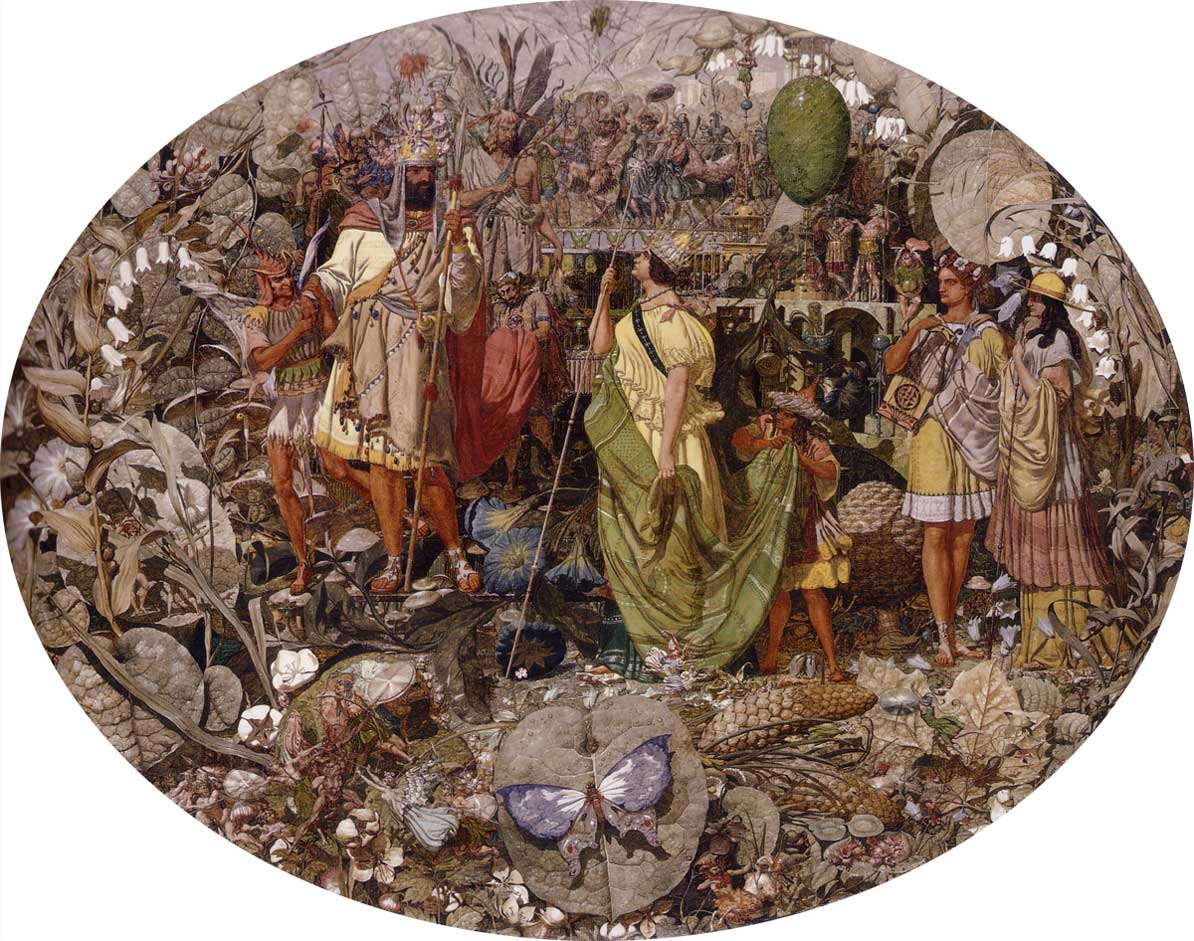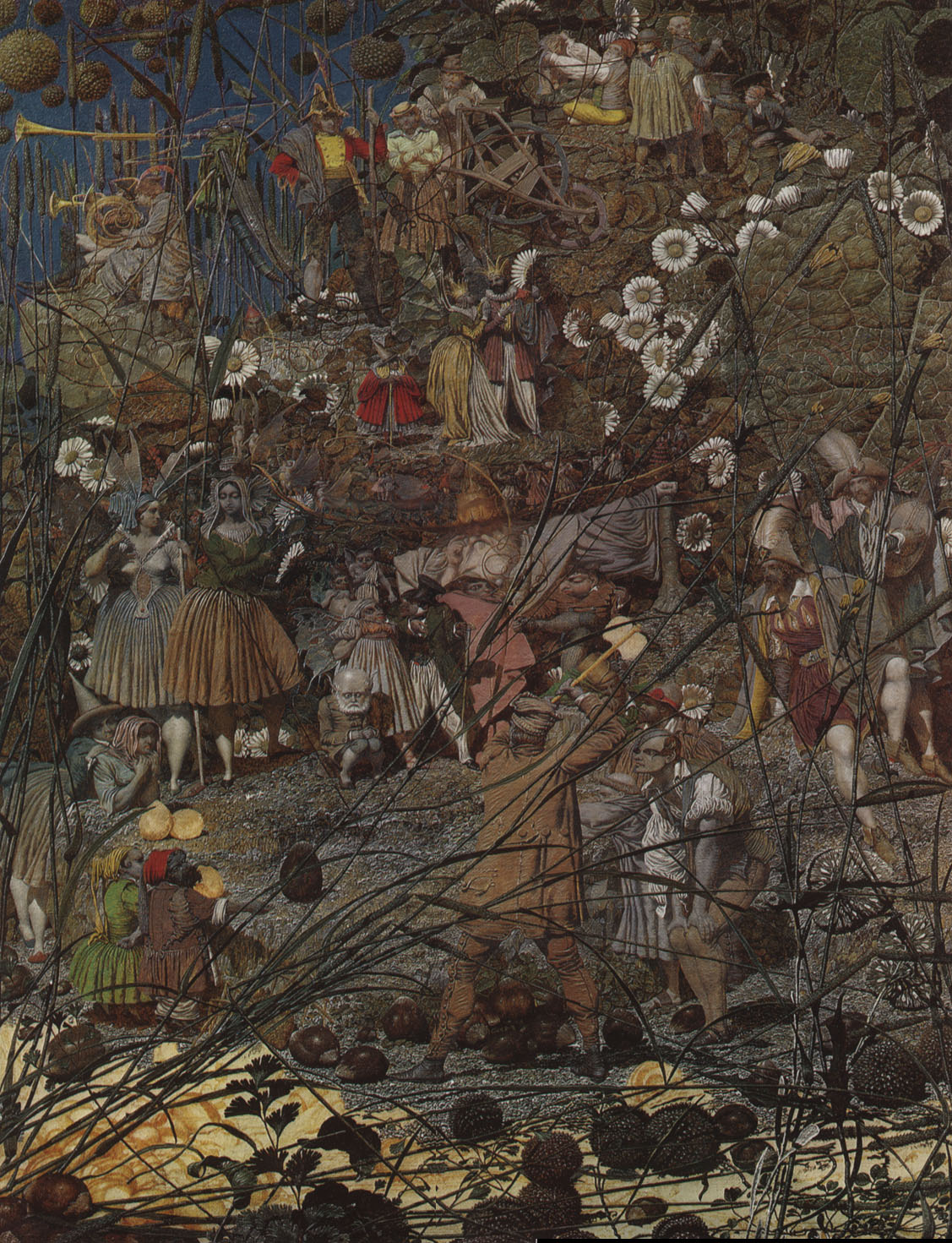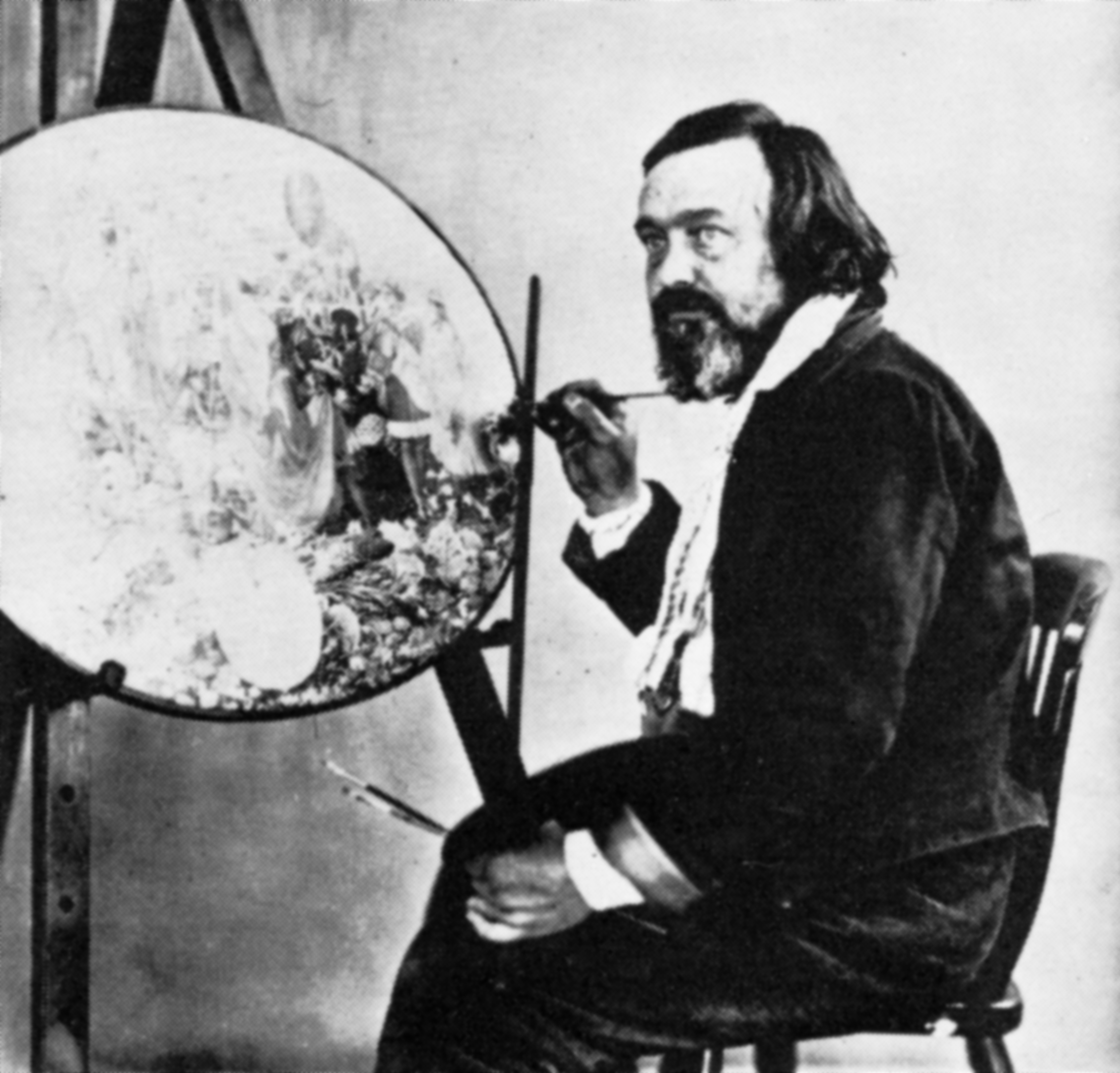Victorian Osiris Kills Father and Paints Fairies April 30, 2012
Author: Beach Combing | in : Modern , trackbackNow that the happy days of summer are here Beach is running away, in his mind, with several projects. There are the bat boxes, visits to the animals’ secret garden in the woods (with elder daughter), an attempt (probably vain) to get a carpenter to put up some shelves and then, chief among Beach’s preoccupations, there is the fairy corridor. Essentially, Beach plans to plaster the upper floor of the Beachcombing mansion with various sketches, artifacts, cartoons, photographs and ceramics relating to the good folk: in part to give his children unquiet dreams, in part to amuse himself. Consequently even though term is not quite over Beach has been on the prowl, salivating over graphic novels, Edwardian art books and stills from the fake fairy archives. And, so far, the most interesting potential contributor to the corridor has been Richard Dadd (obit 1886) who Beach thought that he would celebrate today
Dadd was a high-flying nineteenth-century painter whose career can usefully be split into three phases. (I) The boring phase: when the young and insufferable Dadd painted a series of conventional works (still lifes etc). (II) The fame phase: when an intense Dadd, in his early twenties, began to paint pat fairies and had praise heaped on him. (III) Then, finally, there is the mad phase from his mid twenties onwards which Dadd spent painting two works of utterly unconventional fairies in a top security mental asylum. The two late pictures are ‘Contradiction: Oberon and Titania’ and the simply amazing ‘The Fairy Feller’s Master Stroke’.
How Dadd got from being a preppy Victorian fairy painter in the Royal Academy School to being a moon-barking inmate is a fascinating story in itself and Beach has half a suspicion that the fairies had something to do with it. On a trip to the Middle East in 1842 the still young Dadd began to show violent symptoms, so much so that his well-to-do travelling colleagues, including Sir Thomas Phillips, had the painter sent home early. Either in the Mediterranean or on the way back to his family in Kent Dadd convinced himself that he was the god Osiris (far more original than the staple of most nineteenth-century asylums, Napoleon). And he subsequently stabbed his father to death believing that bounder to be a devil. Dadd almost killed too a traveller on a train in France while trying to escape from arrest and was ultimately brought into the loving embrace of Britain’s surprisingly enlightened nineteenth-century Bedlam, Bethlem Royal Hospital.
It is always easy to identify the Osirises in our midst with hindsight: there is a worrying intensity in even mad Dadd’s early fairy pictures (see the one that heads this post), some scary nudes and over-red sunsets. But that intensity is as nothing compared to the hell that was to follow. Of course, Midsummer Night’s Dream was a staple of Victorian artists trying to fairy-up: as to a lesser extent was the Tempest. But no one painted Shakespeare like Dadd. If you look at the figures in this image (‘Contradiction’ above) you will see a worrying inability to communicate. No one is looking at anyone else, they seem all to be looking into space. Frequent comparisons with Bosch then are misplaced because Bosch’s infernos fit together like perfectly worked jigsaws. Yet, at the same time, Dadd’s characters are all clearly part of the same food chain with grand fairies and big fairies, and small fairies and beneath them tiny fairies and finally, we might imagine, microscopic fairies feeding on still smaller fairies and each other. It is an airless work, with no lush vegetation, only the kind of leaves that you would find in the drier parts of the Australian Bush. When Beach spent twenty minutes looking at it this evening he just wanted to throw open the window and let some air in. It took Dadd four years to paint.
The Fairy Feller’s Master Stroke (that will almost certainly appear in the corridor) is more impressive and perhaps more frightening. An axe man (who could be Dadd) is about to split a hazelnut. And once more around him are a series of figures who are disconnected: their glances disconcertingly do not meet. But they are also clearly associated by their dress and their body language and the profusion of terrifying daisies everywhere. The connect-disconnect feeling is summed up for Beach by the fact that he is not sure which hazelnut the feller is about to crack. Is it the one directly at the man’s feet or the one about a yard away. Confusingly the pose the feller has taken up will not bring the axe to either: the visual experience is the same as that of staring at some of the early Renaissance works where perspective had still not been worked out and light seasickness results. This work, in any case, took Dadd nine years.
Not satisfied with just painting his nightmares Dadd wrote a poem about the Fairy Feller named Elimination of a Picture and its Subject which is about four thousand words long. A sample? ‘To your judgment I must bow Freely its exercise allow You perhaps to such are more inured. Your notions may be more endured But whether it be or be not so You can afford to let this go For nought as nothing it explains And nothing from nothing nothing gains.’ Paranoid schizophrenia probably works better in paint than in prose.
Beach is fascinated in fairy art at present, any off-the-beaten-track examples gratefully received: drbeachcombing AT yahoo DOT com
And here is mild Dadd, his knifing days behind him, painting Contradiction.
***
30/April/2012: Invisible writes in: You undoubtedly have run across the fairy art of Charles Altamont Doyle (father of Arthur Conan Doyle). Also mad (he was an alcoholic, had seizures, and was periodically institutionalized) but his fairies are more whimsical and certainly less dire than Dadd’s whose work I cannot contemplate without feeling like I want to throw myself under a train. I can recommend The Doyle Diary: The Last Great Conan Doyle Mystery with a Holmesian Investigation into the Strange and Curious Case of Charles Altamont Doyle. There are very cheap used copies on bookfinder.com. More of a sketchbook than a diary–written/drawn while in a Scottish lunatic asylum. He seems to have been a loveable lunatic–the book is full of his witty appeals to his doctors, trying to prove he was not insane. Here are some pictures. Southern Man writes in with some suggestions for the corridor. The Cottingley Fairies (of course), engravings from nineteenth century books particularly Sykes, some of the early modern engravings of fairy hills, modern photographs with bits of luminous dust floating through the atmosphere, fairy sites on antique postcards, Neil Gaiman’s Midsummer Night’s Dream, particularly his version of Puck, Victorian stage girls dressed as fairies – preferably floating through the air. Thanks Invisible and SM!
5 May 2012: Fairy Avenger writes: Beach, liked very much this piece though you had not taken into account the latest scholarship, namely Patricia Allderidge’s excellent biography of Dadd in the Oxford DNB. I’ve copied out some of the relevant bits for you. I have some other fairy mistakes that you’ve made in your posts that I’ll include in the next months [!!]. Note, for example, that Dadd did not – contrary to earlier biographical sketches – believe that he was Osiris but that he was serving Osiris. ‘To those who knew him, Dadd’s character appeared to have changed. He had become watchful, suspicious, and unpredictable, concealing the fact that he was receiving messages and instructions from unknown sources (probably in the form of voices), but occasionally dropping hints that he was pursued by evil spirits, and was himself searching for the devil. Eventually he came to believe that the Egyptian god Osiris was the supreme being controlling all his actions, and the source of his ‘secret admonitions’. However, for much of the time Dadd still behaved normally… After a period of apparent recovery Dadd’s condition worsened again, and on 28 August 1843 he persuaded his father to accompany him to Cobham Park in Kent, near to his childhood home of Chatham, where he stabbed him to death with a knife bought specifically for the purpose. Dadd later explained that he had killed the devil in disguise, and seems to have retained this belief throughout his life, talking objectively about the murder as an event for which he held no personal responsibility. He made his way to France, but was arrested after trying to cut the throat of a stranger who was travelling with him in a carriage. Dadd was confined in a French asylum for ten months, and extradited in July 1844 to appear before the magistrates at Rochester. Though formally committed for trial, he was certified insane and was admitted on 22 August to the state criminal lunatic asylum attached to Bethlem Hospital at St George’s Fields in Southwark, south London. He was never to know freedom again. The ‘government wing’, where Dadd was first confined, had been built in 1816 to house patients sent by the courts and later through other legal channels. It was a prison-like block with heavily barred windows at the back of the main building, largely untouched by reforms which were taking place in the rest of the hospital. The internal environment was dark, cramped, and dismal, the outer world restricted to a bleak, high-walled exercise yard, and many of his companions were hardened criminals who had become insane while in prison. Dadd’s living conditions were much improved in 1857, when he and some of the ‘better class’ of criminal patients were moved to a specially converted ward in the main hospital, but far greater improvements occurred in 1864, when all the criminal patients were transferred from Bethlem to the new state asylum of Broadmoor in Berkshire… For some years Dadd was considered a dangerous patient, being unpredictable and sometimes violent, his conversation being rambling and incoherent when touching on the subject of his delusions. However, he soon began to work again in Bethlem, and effectively maintained his career as a painter for the rest of his life, though his pictures were rarely seen outside the asylums. A visitor in 1845 wrote of some recent drawings that they In Broadmoor Dadd’s talents found additional outlets, in painting scenery and a drop curtain for the theatre (now des.), as well as murals, furniture, and other decorative items, and in more ephemeral activities such as the production of comic cartoon figures at Christmas, and diagrams and illustrations for lectures and entertainments. Interviewed at the age of sixty, he appeared by this time to have accepted his fate, but still considered it unjust, feeling that society did not understand him. Dark and handsome in his youth, with expressive features, in later years he gave the impression of a scholarly recluse, with a snow-white beard and mild blue eyes gazing benignly from behind spectacles. Throughout the desolate circumstances of his later life he had clung to his identity as an artist, and although his personality was radically changed, insanity had not destroyed his intellect. He retained the delusion that he was subject to the will of Osiris, but after three decades in an asylum he still talked with intelligent interest about painting and the art world, read the Satires of Juvenal, and played the violin.’ Thanks FA!






